Rich data illuminates stories of Charlottesville and beyond
It’s Love Data Week! This year’s theme is “My Kind of Data,” and we have a guest post from Laura Hjerpe, Senior Research Data Management Librarian.

In recognition of Love Data Week 2024, I’m featuring Charlottesville data stories from the University of Virginia Equity Center and local data from the City of Charlottesville, the Commonwealth of Virginia, and the U.S. Government. I chose this because my kind of data is a data story with human interest, backed up by reliable data sources.
Data stories from the Equity Center
Health outcomes in the Charlottesville region, one of three Picturing Climate Justice data stories from the Equity Center, begins with a discussion about how environmental factors connected with climate change can affect physical and mental health, especially that of African Americans. Eight visualizations show the relationships between socioeconomic characteristics, such as income, racial demographics, age, and location with health outcomes such as asthma, diabetes, and poor physical health. Every visualization is accompanied by variable definitions, data sources, and Python code used to create the visualizations. Additionally, a new piece on Charlottesville Urban Heat Islands has been added that updates prior climate equity work. You may find this report and others on the Charlottesville Regional Equity Atlas by scrolling down and clicking “See all Reports.”
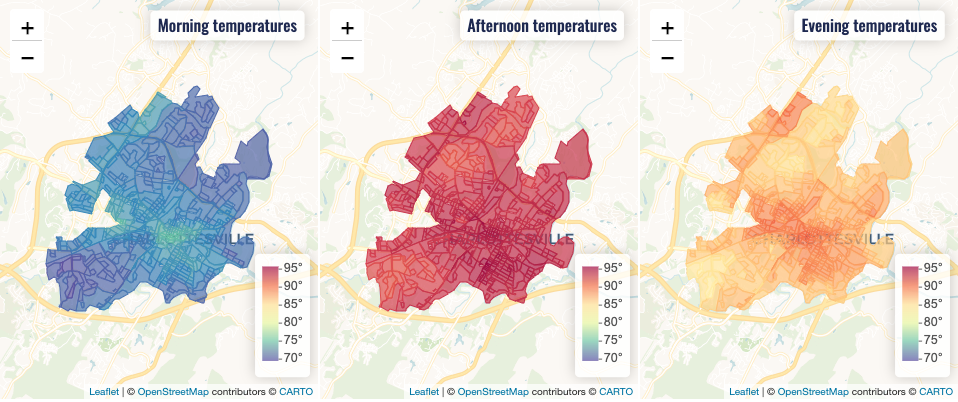
The Charlottesville Regional Climate Equity Atlas can be used to explore social, infrastructure, and climate measures. To use, select any two measures to see the relationship between the measures in census tracts across the greater Charlottesville region. Researchers may narrow visualizations to specific counties or to the city of Charlottesville and choose from eight categories of variables: Demographic and Social, Health, Youth and Education, Jobs and Income, Housing and Transportation, Risk Factors, Community Assets and Infrastructure, and Climate Measures. After selecting a measure, the system shows that measure’s definition and data source.
These resources not only amplify data about Charlottesville area residents, but they also walk the reader through the data to make it easier to understand.
Local data collections
Charlottesville has a number of local data collections. First, Charlottesville Open Data has municipality-generated data, such as Real Estate (Commercial Details) and a Tree Inventory. It features Charlottesville maps with city operations, historical preservation, and Green City data.

Equity and Open Data features local historical data, as well as stories such as Union Ridge Today, a story told with maps about the transition of a neighborhood from Black-owned farmland to a busy Charlottesville suburb. There is overlap of datasets with Charlottesville Open Data, since both sites focus on local data.
Virginia Open Data Portal contains Commonwealth-wide data. Popular topics include COVID-19, policing, food, and civil suit judgements. One popular historical dataset is called Freedom Suits which contains petitions initiated by enslaved people seeking to gain their freedom. Details extracted from these petitions include names, ages, years, claims, and judgements. The full text digital documents may be retrieved by file name from Virginia Untold: The African American Narrative. This collection, from the Library of Virginia, provides access to digital records documenting lived experiences of enslaved and free Black and multiracial people.
Local data from the U.S. government
The 2015-2019 American Community Survey (ACS) 5-Year Estimates found in Social Explorer are produced by the federal government and contain local data from communities throughout the United States, including the Charlottesville area. The 2015-2019 ACS 5-Year Estimates is a nationwide survey that asks about topics such as education, employment, internet access, transportation. The 5-year estimates represent data collected over 60 months and provide multiyear estimates for geographic areas with fewer than 65,000 residents. For more information about the ACS survey, see Understanding and Using American Community Survey Data: What All Data Users Need to Know.
CDC Places, a collaboration between the Centers for Disease Control and Prevention (CDC) and the Robert Wood Johnson Foundation, reports county, place, census tract, and Zip Code Tabulation Areas (ZCTA) data and uses small area estimation methods to obtain 36 chronic disease measures.
Ready to find your own data? Visit our Data and Statistics LibGuide for search strategy tips and to find data archives, data on a topic, and more.
Visualization training
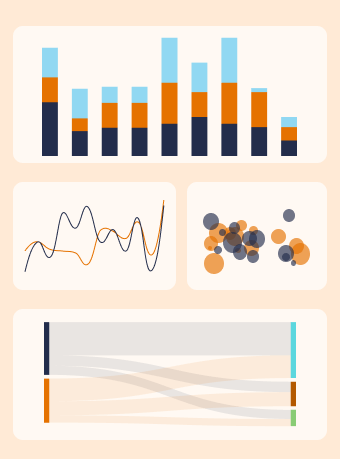 Do you want to get started with visualizing your own data? Check out our RDS workshops. If you can’t make a session, reach out to the instructor for a one-on-one consultation.
Do you want to get started with visualizing your own data? Check out our RDS workshops. If you can’t make a session, reach out to the instructor for a one-on-one consultation.
Do you want to enhance your story with maps? Visit Scholar’s Lab GIS Workshops. Coming up soon, Web Mapping and Visualization and Spatial Analysis with ArcGIS Online are offered during the last two weeks in February. Both workshops are one hour and assume no previous experience using GIS.
There are lots of ways we can help — visit our Research Data Services site to learn about what we can offer. If you need help with finding data or using visualization tools, analyzing the data you already have, or managing your data, reach out to researchdataservices@virginia.edu.
.
Trio of exhibitions examines Black life 100 years ago, with a focus on Central Virginia
On a warm day last June, visitors flocked to the Albert and Shirley Small Special Collections Library for a “Family Day” event in celebration of the library’s blockbuster exhibition, “Visions of Progress: Portraits of Dignity, Style, and Racial Uplift,” curated by UVA Associate Professor of History John Edwin Mason. Since its installation in September 2022, the exhibition, which showcased portraits that African Americans in Central Virginia commissioned from the Holsinger Studio in the early 20th century, had drawn national media attention and attracted more than 10,000 visitors, nearly double the average amount. On this day in June 2023, families came to say goodbye to the exhibition just before it closed, and to have their own portraits taken as well.
Inside the Main Gallery of the Harrison Institute and Small Special Collections Library, modern-day Charlottesville residents found Holsinger portraits of their ancestors. Outside, families posed among the lush greenery for tintype portraits taken by Richmond photographer Em White, who was hired by Special Collections for the event. Nearby, visitors climbed inside the Free Book Bus to peruse titles, while on the first floor of the Harrison/Small building, children and teens participated in a “Zine Jam” workshop, cutting and pasting images to create their own tiny magazines.
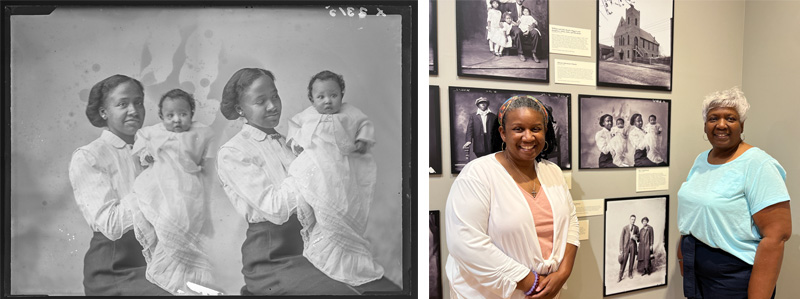
“We had always wanted to do an event like Family Day for the local community,” said Holly Robertson, Curator of University Library Exhibitions, who organized the event and co-curated the Holsinger exhibition. “But it’s one thing to want to do an event, it's another thing to actually pull it off. ‘Visions of Progress’ had such good momentum, from the opening night to the media high of being featured on PBS News Hour in the dead of winter, and it really kept people coming to the exhibition, interested in the exhibition, writing in to say, ‘Hey, my relative is in here!’ It was an incredible, constant wave of positivity that propelled us to do a ‘last hurrah’ of sorts with Family Day.”
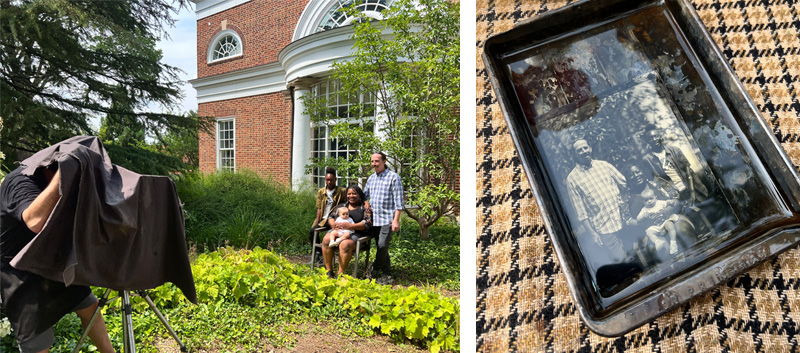
The success of “Visions of Progress” also inspired the curatorial team to continue examining Black life in the United States 100 years ago. “In thinking about other things that we wanted to highlight, both from a curatorial interest from staff and faculty, as well as a timely interest … we realized the Harlem Renaissance was what we wanted to do next,” Robertson said. As “Visions of Progress” wound down, Robertson worked with Special Collections curators Krystal Appiah and George Riser to dive into the Library’s rich collection of Harlem Renaissance artifacts, including books, magazines, illustrations, and manuscripts of the writers, artists, and thinkers of that era.
Looking back at the Harlem Renaissance
In September, 2023, UVA Library launched its latest major exhibition, “Their World As Big As They Made It: Looking Back at the Harlem Renaissance” in the Main Gallery of the Special Collections Library with an opening-night reception that featured live music from the Charlottesville Jazz Congregation. The curators had interpreted the cultural zeitgeist correctly; attendance for the event was at capacity, and just before the opening, the Metropolitan Museum of Art announced plans for its own Harlem Renaissance exhibition (launching later this month).
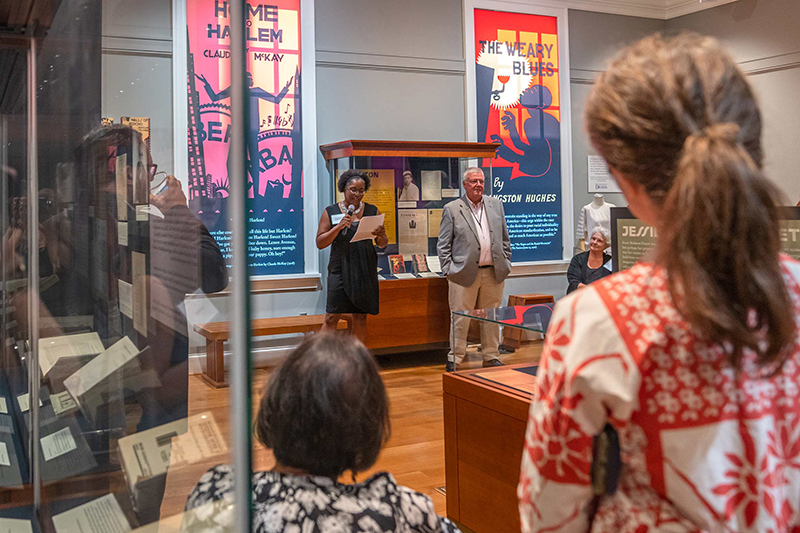
The exhibition’s title is inspired by the Georgia Douglas Johnson poem, “Your World,” in which she looks back at the creativity of the Harlem Renaissance, acknowledges the hardships of being an emerging artist, and beckons a new generation of Black artists, writers, poets, and publishers with the line: “Your world is as big as you make it.” Johnson published her first poems in 1916 in the National Association for the Advancement of Colored People’s magazine The Crisis, which is featured prominently in the exhibition.
“Our original idea for the exhibition was to take the three major magazines from Harlem from the period: Opportunity, The Messenger, and The Crisis, which all had different approaches to what they called ‘Negro uplift’ during the Great Migration, amid a background of incredible violence that was being perpetrated at that time,” said Riser, one of the exhibition’s curators. The works in the exhibition show “the countering of that violence, through this renaissance of art and poetry and music,” he said.
In addition to the original editions of those magazines, the exhibition features the papers of Langston Hughes; first editions of books by Claude McKay, Zora Neale Hurston, and Countee Cullen; as well as fashions and music from the era, thanks to contributions from Sophie Abramowitz, a specialist at Smithsonian Folkways Recordings (and former student assistant for Special Collections) whose graduate dissertation focused on songwriting in the Harlem Renaissance. Marlon Ross, a UVA English professor, also assisted with curation. Many of the items in the exhibition were originally collected by UVA Library soon after they were published. “Not many institutions have a [Harlem Renaissance] collection like ours,” curator Krystal Appiah told UVA Today. [See below for the curators’ favorite elements of the exhibition.]
Inspired by the way “Visions of Progress” drew in the local community through ancestral connections, Library curators put out a call this past summer for present-day artists to create works that would explore or respond to poems by Harlem Renaissance authors. The project, titled “As Big as We Make It!” was sponsored by a grant from the UVA Arts Council. A selection committee chose five contemporary artists with connections to UVA and Charlottesville to showcase their work in the exhibition. Read more about them here.
Curators provided tours of “Their World As Big As They Made It” to more than 600 middle school students on field trips just in the first three months of the exhibition run — and they will welcome almost 1,000 more Charlottesville-area high school students before the end of this month. In late January, more than 1,000 people registered to attend a virtual behind-the-scenes tour of the exhibition through UVA Lifetime Learning. On April 26, the Library will hold an open-house Final Friday celebration of the Harlem Renaissance. And for those traveling to Charlottesville for the 2024 Black Alumni Weekend or either Reunions weekends, the Library will offer in-person curator-led tours of the exhibition.
Sneak Peak: Curators share their favorite elements of “Their World As Big As They Made It: Looking Back at the Harlem Renaissance”
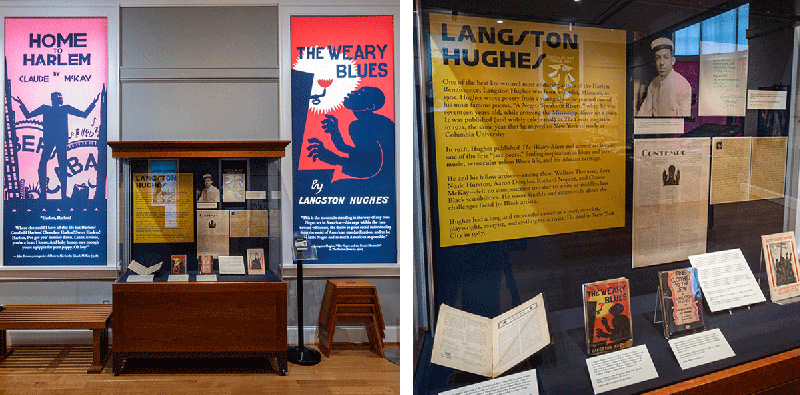
— Krystal Appiah, Head of Collection Development at the Small Special Collections Library
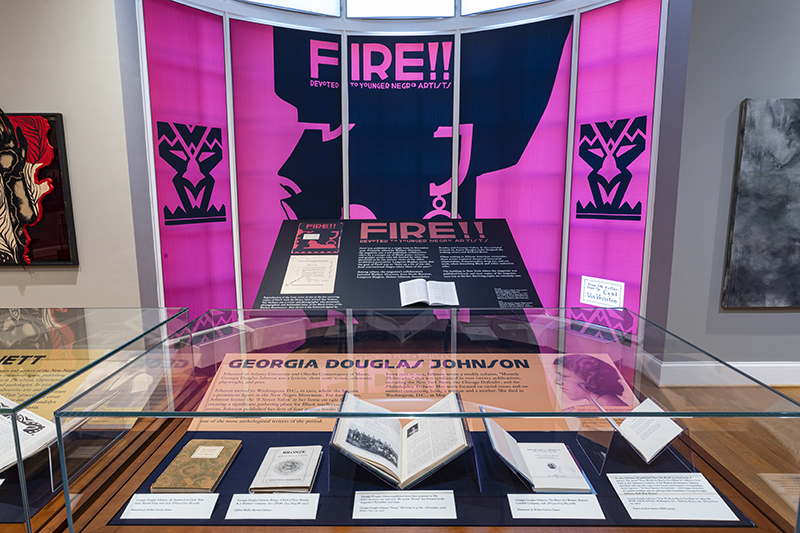
— George Riser, Instruction and Curation at the Small Special Collections Library
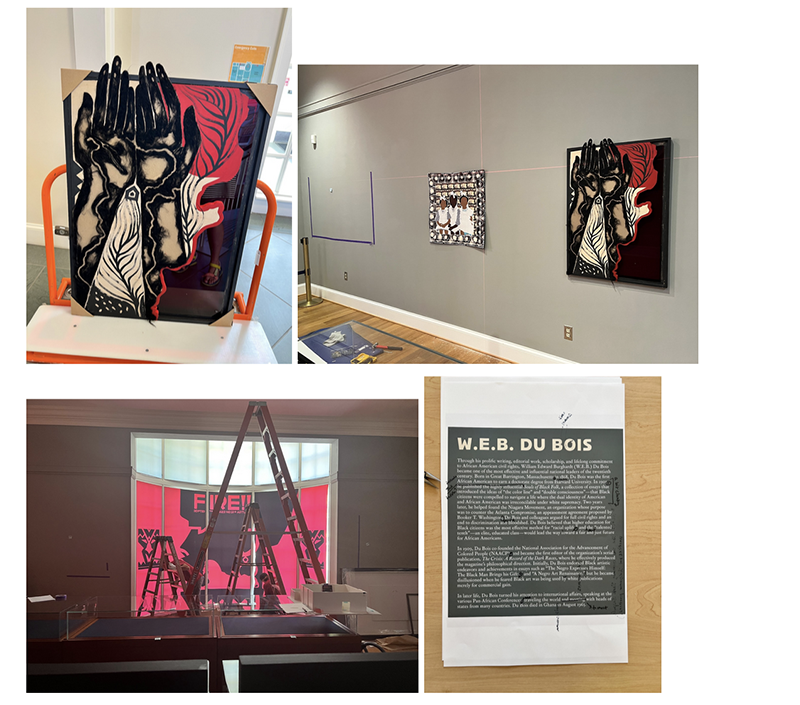
— Holly Robertson, Curator of Exhibitions for the Small Special Collections Library
Looking ahead: The world of Anne Spencer
As Robertson was working on building on the Harlem Renaissance exhibition, she realized the Library had an opportunity to continue to examine Black life a century ago through the lens of poet Anne Spencer, a Virginia native who was an active figure in the Harlem Renaissance. UVA Library holds a vast collection of Spencer’s work and papers and this will be the subject of the next major exhibition opening in the Main Gallery of the Special Collections Library in September 2024. “I see ‘Visions of Progress,’ the Harlem Renaissance, and Anne Spencer as a triptych of exhibitions that look back at the African American experience 100 years ago, with a focus on Charlottesville and Central Virginia,” Robertson said.
Spencer lived most of her life in Lynchburg, Virginia, but had a strong presence in the literary world of the Harlem Renaissance. Her first published poem appeared in The Crisis and subsequent work was published in “The New Negro: An Interpretation,” a 1925 anthology of fiction, essays, and poetry edited by Alain Locke that served as a central text of the Harlem Renaissance, pushing for social and political change. In addition to being a poet, Spencer was a teacher, librarian, mother, gardener, and activist who helped revitalize the Lynchburg chapter of the NAACP, and her Lynchburg home was a meeting place for writers and intellectuals including Thurgood Marshall, Langston Hughes, and W. E. B. DuBois.
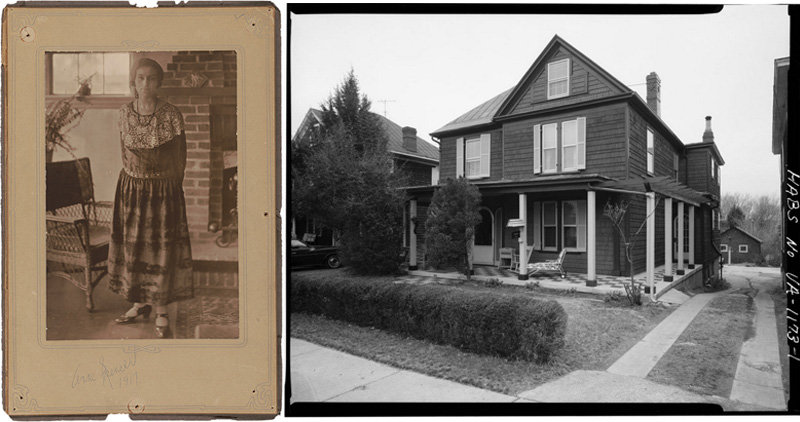
Spencer’s house is now a museum, maintained and run in part by her granddaughter, Shaun Spencer-Hester. “I just traveled to the museum recently and it is so beautiful,” Robertson said. “It is a liberated woman’s space, complete with a writer’s studio and gorgeous garden. The museum is starting to get its own national attention and funding. It feels like the right time to recognize the Library’s Spencer collection, which scholars are publishing on these days — and to lift up and celebrate the work of Shaun Spencer Hester as well.”
Robertson hopes to build the exhibition space to allude to architectural elements of the Spencer house and garden. “I keep thinking about family trees and the beautiful garden that [Spencer] left,” she said. “I plan to situate exhibition cases like trees, like the arbors that you see in the garden, giving people a sense of the beauty that they can behold and the story that they can behold about this incredible civil rights activist, librarian, and poet who brought the Harlem Renaissance into her own home.”
To see our latest major exhibition, “Their World As Big As They Made It: Looking Back at the Harlem Renaissance,” in person, visit the Main Gallery of the Special Collections Library, open weekdays and Saturday afternoons. Or attend our Final Friday event on April 26, 2024, for an open house-style celebration featuring gallery talks by exhibition curators.
From Jacob Lawrence to Tupac Shakur, check out UVA Library’s recommendations for Black History Month 2024
Since 1976, the U.S. government has officially observed February as Black History Month, with the Association for the Study of African American Life and History designating a theme each year. The theme for Black History Month 2024 is “African Americans and the Arts,” and UVA librarians are excited to offer recommendations for books, films, and even datasets that examine Black culture, history, and creativity. This year’s recommendations come from Reference Librarian Mandy Rizki and, where noted, from Keith Weimer, Librarian for History and Religious Studies. For more recommendations, also see our posts commemorating Black History Month 2023, Black History Month 2022 and Black History Month 2021.
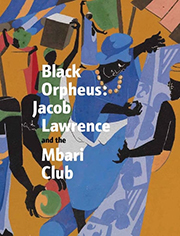 “Black Orpheus: Jacob Lawrence and the Mbari Club,” edited by Kimberli Gant and Ndubuisi Ezeluomba (2022)
“Black Orpheus: Jacob Lawrence and the Mbari Club,” edited by Kimberli Gant and Ndubuisi Ezeluomba (2022)
I was first introduced to Jacob Lawrence when I lived in Washington, D.C., and was lucky to be able to visit half of his “The Migration Series” at the Phillips Collection often. The other half lives at the Museum of Modern Art in New York. This book, “Black Orpheus,” explores the relationships between Lawrence and the members of the Mbari Artists & Writers Club through artwork, of course, but also through archival materials, essays, photographs, and images of the Mbari Club’s arts magazine, Black Orpheus (1957-67). Inspired by Lawrence’s lesser-known “Nigeria” series from the 1960s, this gorgeous exhibition catalog explores the huge, yet often ignored, impact of African Modernism on Lawrence’s practice and on art history globally.
Available in print.
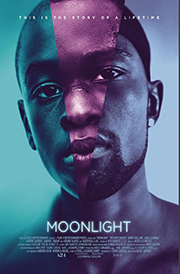 “Moonlight,” by Barry Jenkins (2016)
“Moonlight,” by Barry Jenkins (2016)
You may remember this 2016 film for winning Best Picture and Best Supporting Actor — to Mahershala Ali — at the Oscars. Nearly eight years away from the revelation of its release and the buzz of awards season, the movie has aged to an even more beautiful, moving, thoughtful experience. Queer identity is easier to find in media now than ever before, but to explore queer sexuality is still so rare, even more so Black queer sexuality. “Moonlight,” available on SWANK Streaming Film Database, does just that, in luminous color and amazing performances through all three chapters of the film.
Available on SWANK Streaming Film Database.
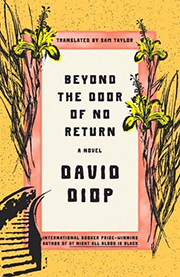 “Beyond the Door of No Return,” by David Diop, trans. Sam Taylor (2023)
“Beyond the Door of No Return,” by David Diop, trans. Sam Taylor (2023)
Set mostly in the 1750s in Senegal, this 2023 novel by David Diop (translated by Sam Taylor) layers language, time, relationships, truth, and imagination. The main character, Michel Adanson, was really a botanist who worked in Senegal in the 18th century. Diop, himself French-Senegalese, has taken Adanson as a starting point to imagine a story about his experiences traveling through the heart of the transatlantic slave trade, including descriptions of the House of Slaves and its Door of No Return on Gorée, off the coast of Dakar. You may recognize this historic location from other novels, including those by Kwame Alexander and Yaa Gyasi. Diop’s epistolary book, translated from French, completely engages us in the lives of Adanson and his daughter, Aglaé, with skillful writing. Its vivid descriptions and astute observations move what may have been a trite novel into a mesmerizing work.
Available in print.
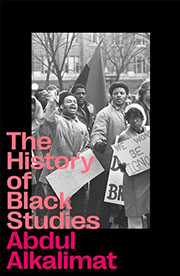 “The History of Black Studies,” by Abdul Alkalimat (2021)
“The History of Black Studies,” by Abdul Alkalimat (2021)
Alkalimat, a professor of African American Studies and of Library and Information Science, has worked in the field of Black Studies since its founding in the 1960s. This chronicle, therefore, is based in both historic research and first-hand experience. Alkalimat describes how Black Studies departments were born out of political movements from student activism to Black Power, and doesn’t underplay the impact of the women’s movement and co-ed activism on the creation of these departments and programs. Simultaneously, Alkalimat reminds us that Black intellectualism existed long before the institutionalization of Black Studies. Check out his subsequent book too, The Future of Black Studies.
Available in ebook.
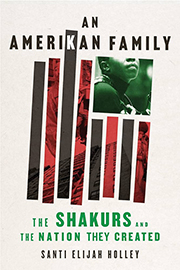 “An Amerikan Family: The Shakurs and the Nation They Created,” by Santi Elijah Holley (2023)
“An Amerikan Family: The Shakurs and the Nation They Created,” by Santi Elijah Holley (2023)
This 2023 publication reviews the history of the Shakur clan and their commitment to Black resistance movements from Marcus Garvey’s Universal Negro Improvement Association in the early 20th century, the Nation of Islam, the Black Panthers and its offshoots — including the violent Black Liberation Army — and the cultural activism of rapper Tupac Shakur. Patriarch Salahdeen Shakur ties the various figures and movements together, though much attention is paid to his daughters-in-law Afeni Shakur (Tupac’s mother) and Assata Shakur (still a fugitive in Cuba). The book offered a clear overview of important currents of thought, organizations, and personalities within the Black community, as well as the connections between them.
Available in print. (This recommendation was provided by Keith Weimer)
National Survey of Black Americans Series, by James S. Jackson, Harold W. Neighbors, M. Belinda Tucker, and Gerald Gurin
Novels, books, and films are crucial to understanding and celebrating Black history and culture — so is data! Many institutions and research centers create datasets studying Black communities, health, experiences, and much more. This particular dataset from the University of Michigan’s Institute for Social Research, spanning 1979 to 1992, is focused on social, economic, and psychological data of Black Americans. Other publicly available datasets on Black American life can be found via Pew Research, the US Census Bureau, and more. Our Research Data Services team is here to help you work with data and find datasets. Attend a workshop to dive deep on software or visit the StatLab by appointment or walk-in hours.
Available from the Institute for Social Research at the University of Michigan.
Don't miss this event! “Looking Back at the Harlem Renaissance”
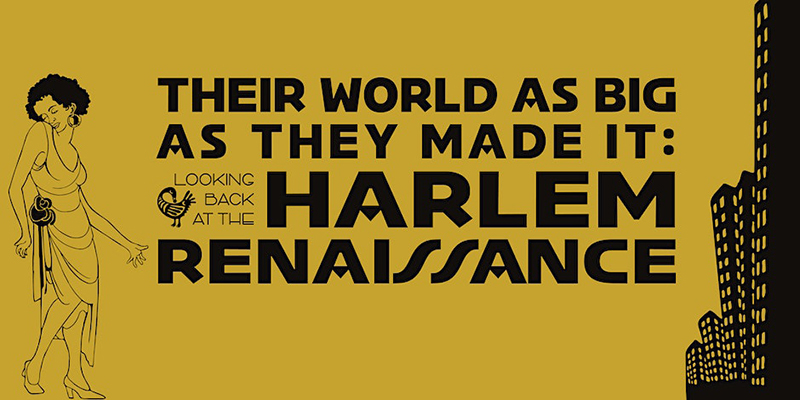
Join Lifetime Learning and the UVA Library for a virtual tour of the current exhibition “Their World As Big As They Made It: Looking Back at the Harlem Renaissance,” featuring the visionary works of writers, artists, and thinkers whose creative and intellectual pursuits defined Black American identity and political consciousness. The Albert and Shirley Small Special Collections Library is fortunate to hold a wide selection of influential books, magazines, illustrations, and manuscripts from the Harlem Renaissance.
The exhibition curators—Marlon Ross, Krystal Appiah, and George Riser—will offer a look back one hundred years ago when the artistic and political revolutions of the Harlem Renaissance were in full swing. They will also offer a behind-the-scenes chronicle of their work, producing a highly visual exhibition in conversation with Black artists today.
Event details:
Wednesday, January 24, 2024
3-4 p.m. EST
Virtual event with live captioning
Free and open to all; register here
Speaker biographies:
Marlon Ross, Professor of English, Department of English, College and Graduate School of Arts and Sciences
Krystal Appiah, Head of Collection Development, the Albert and Shirley Small Special Collections Library
George Riser, Curator, the Albert and Shirley Small Special Collections Library
Holly Robertson (moderator), Curator, the Albert and Shirley Small Special Collections Library
Library guide offers support for navigating AI in the classroom

Earlier this week, Indian cricket star Sachin Tendulkar spoke out about a deepfake video surging on social media in which Tendulkar appeared to be promoting a gaming app as an easy way to make money. “It is disturbing to see rampant misuse of technology," Tendulkar stated on X (formerly Twitter). Tendulkar is just the latest victim in the rise of deepfakes. According to The Guardian, more than 100 deepfake videos impersonating United Kingdom Prime Minister Rishi Sunak appeared on Facebook in the last month, raising widespread concern about the damage artificial intelligence (AI) is causing before the country’s general election.
“Deepfake generators are tools that can edit videos to make it look like someone has done or said something they haven’t,” said Josh Thorud, a Multimedia Teaching and Learning Librarian at the University of Virginia Library. “As you can see, this technology is both exciting and frightening in its possible uses — everything from creative exploration to fake news, scams, false criminal evidence, and bullying or blackmail through impersonation.”
Thorud is part of a UVA Library team that offers resources to navigate the increasingly complicated landscape of AI in higher education. The group created a free guide for students and faculty, “Generative AI at UVA,” which features links and information about AI, including ethical use, citations, considerations for use, and more. The guide is one of nearly 600 online guides created by Library staff.
Novices to AI can start with the guide’s “What is Generative AI” section, which explains how programs like ChatGPT use artificial intelligence to create and produce new content through algorithms. Instructors who are teaching about the effects of AI on society or who are concerned about the use of AI in scholarship may want to explore the guide’s “Cautions and Considerations” section, which discusses how to use AI critically, taking into account knowledge gaps; risks of plagiarism and perpetuating misinformation; and complex concepts of bias, privacy, and equity. Students who are using permissible AI-generated content in their academic writing should check out the “Citations” section.
Thorud designed the guide’s “Images and Media” section, which examines how AI can produce artwork, music, and videos — including deepfakes — and all of the concerns that come with that. “By engaging with deepfakes in the classroom, students can critically examine the implications of this technology and develop media literacy skills by looking at misuse and getting hands-on experience of their own,” Thorud said. “And when it is so easy to create fakes, the only barrier is ethics, empathy, and integrity. This calls for an imperative in our classrooms to embed ethical decision-making and critical analysis as core components of media literacy.”
The guide also provides helpful links to wider work on AI going on at UVA, including a generative AI teaching hub through UVA’s Center for Teaching Excellence, which, in addition to a section by Thorud on AI media and non-textual tools, features recommendations from UVA librarians Meridith Wolnick and Maggie Nunley on ethically integrating AI into courses. Wolnick and Nunley worked with Thorud and others to build the Library’s Generative AI guide last fall and urge users to check it frequently for updates and new guidance as AI continues to evolve. “We built this guide at a breakneck speed to get it up,” Nunley said. “Because things are changing and we’re learning so much so quickly, this is going to be a guide that gets updated and changes a lot.”
For instructors who are curious about exploring AI in their classrooms, Thorud recommends striking a balance between technological exploration and critical thinking. “Encourage students to not only learn how to use AI tools, but also to critically analyze their impact on media, society, and ethics through using them,” he said. “This will not only equip students with valuable skills but also prepare them to responsibly shape the future.”
Open doors: First patrons explore the renovated main library
Students, faculty, staff, and community members streamed into the University of Virginia’s newly renovated main library when its doors opened to the public at 9 a.m. sharp for the first time in nearly four years.
Visitors explored five floors of new and updated space. They browsed books in stacks on the fifth floor; studied in the McGregor Room; and bathed in the light streaming in from skylights, clerestories, and massive arched windows. Check out our Instagram page to see a video of the first patrons entering the building.
Photographer Tom Daly was there to capture opening day; take a look at some of the highlights below.
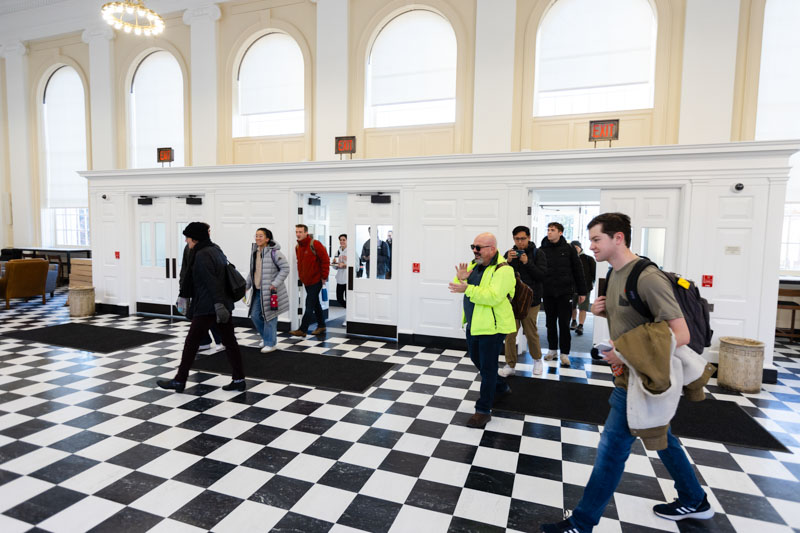
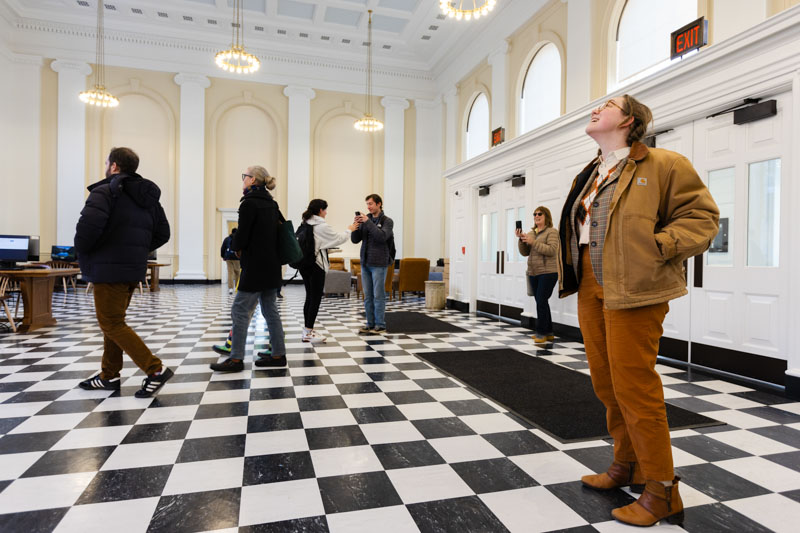
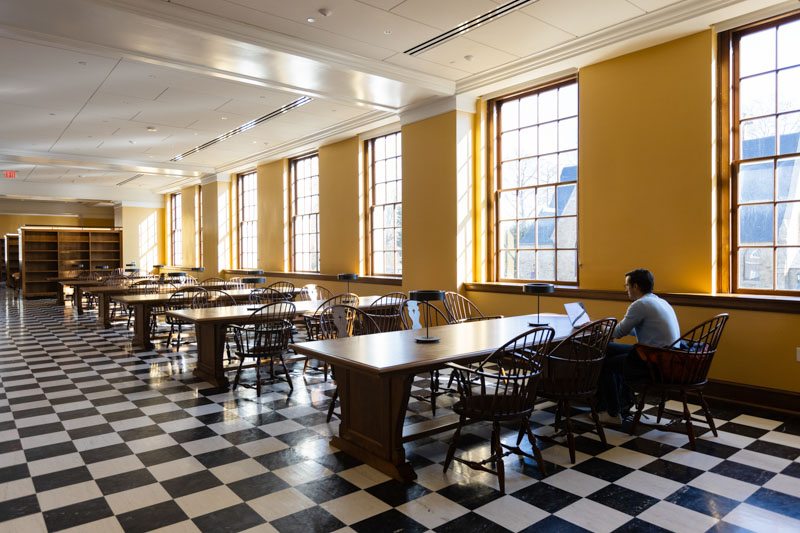



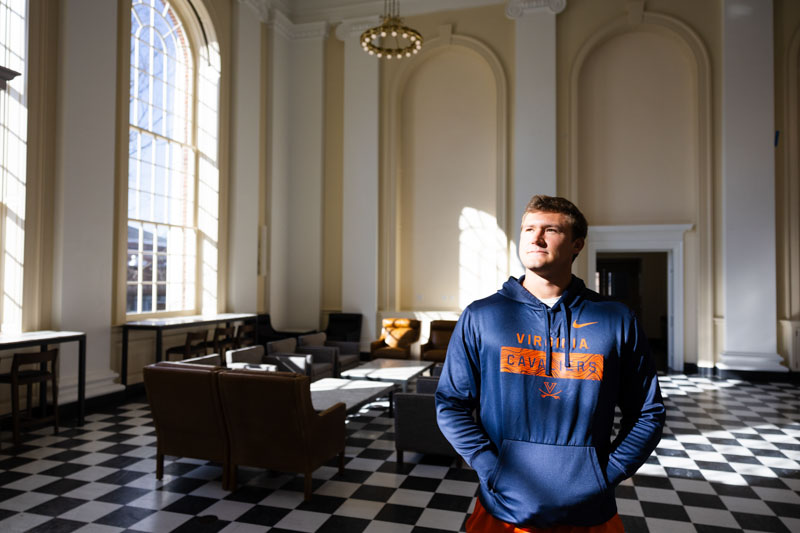

Renovated main library set to open on January 8
The University of Virginia Library is pleased to announce that its main library, which has undergone a transformational, four-year renovation, will reopen to the public on Monday, Jan. 8, at 9 a.m.
The renovation brings the library up to current standards of safety, accessibility, and service. A new north entrance makes the building easily reachable from University Avenue, and a larger south entrance makes the space easier to access from Grounds. The building offers better layout and natural light, including in two new study courts for study, research, and socializing.
Much-loved features such as the McGregor (“Harry Potter”) Room remain — they’ve been renovated and optimized for comfort and character, preserving the essential elements of their unique identity.
Below, photographer Tom Daly captured images of the quiet library days before its opening. For an additional sneak peak of the renovated building, follow our Instagram account.

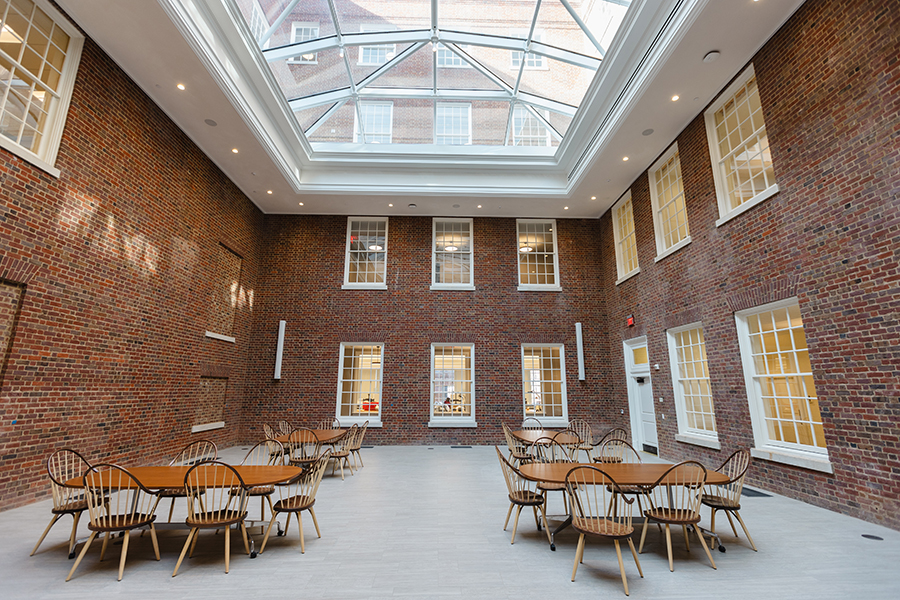
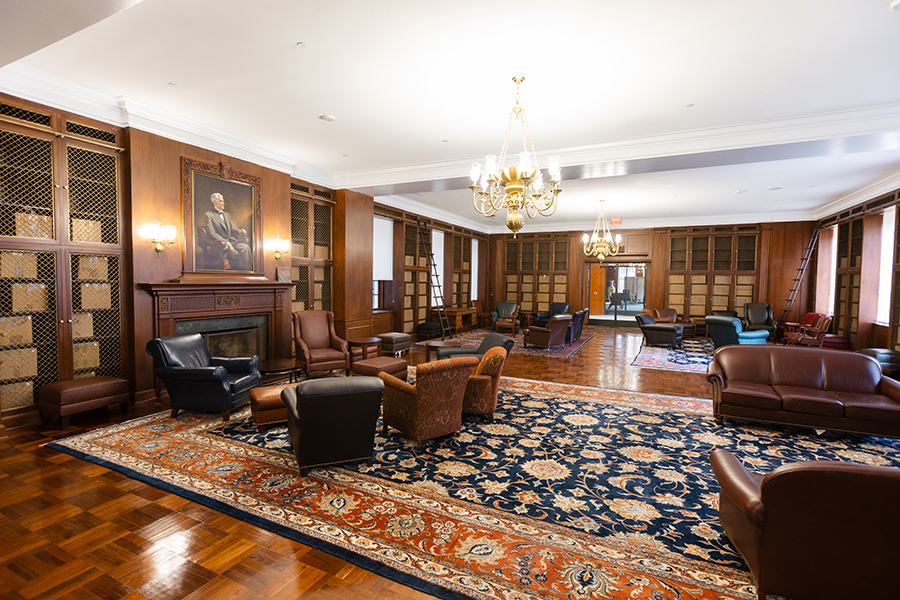
Read more in UVA Today's coverage of the opening.
UVA librarians share their favorite books read in 2023
As the end of the year approaches, we asked UVA Library staff to recommend their favorite books they read in 2023. The books could be any genre, published in any year, so long as they were available in UVA Library’s or the Jefferson-Madison Regional Library’s collections.
Take a look at our extensive list below and check some books out for the holidays. Please note: the publication years listed correspond with the editions in our collections, not necessarily the original publication dates.
Happy reading; see you in the newly renovated main library in January 2024!
Recommended by Sherri Brown, Librarian for English

“How Not to Drown in a Glass of Water” by Angie Cruz (Flatiron Books, 2022)
This quick read swept me up into the daily trials and tribulations of its narrator, Cara Romero, and left me wanting more.
“Tom Lake” by Ann Patchett (Harper, 2023)
A mother recounts the summer she fell in love with a soon-to-be movie star to her children. Like all of Patchett’s novels, a delight.
“Let the Dead Bury Their Dead” by Randall Kenan (Harcourt Brace Jovanovich, 1992)
In 2022 I read Kenan’s posthumously published essays and loved them, so I sought out this collection of short stories. My favorites, including “Clarence and the Dead” and “Things of this World; or Angels Unawares,” delved into the fantastical and supernatural, and stuck with me long after I finished the book.
“Native Son” by Richard Wright (Harper & Brothers, 1940)
I was inspired to read this based on a fall class I worked with. This powerful book has one pondering Bigger Thomas’s motives for murder, the society that influenced his actions, and his reflections after his crimes.
“The Guest List” by Lucy Foley (William Morrow, 2020)
This was my favorite just-for-fun thriller read of the year. A private island, a wedding, many secrets revealed, and a murder – what’s not to like?
Recommended by Ann Burns, Metadata Librarian

“Lessons in Chemistry” by Bonnie Garmus (Doubleday, 2022)
Hasn’t everyone heard of this one? Elizabeth Zott is confident, prickly, and smarter that almost everyone around her, which is what makes her story irresistible. Light but very profound.
“The Land of Lost Things” by John Connolly (Emily Bestler Books, Atria, 2023)
This is a sequel but stands by itself. One of the best and most thoughtful fantasy books I’ve read: the power of stories to teach and to heal.
“Properties of Thirst” by Marianne Wiggins (Simon & Schuster, 2022)
The story of a man trying to keep from losing his rights to the water under his own land while his family navigates the presence of a Japanese internment camp on their doorstep. A stark and beautiful story.
“The Yellow Wife” by Sadeqa Johnson (Simon & Schuster, 2021)
The story of an enslaved woman who lived the role of wife to a white slave trader in 1850s Richmond. This situation is not often addressed and I found the protagonist’s navigation of it frightening and enlightening.
Recommended by Sue Donovan, Conservator for Special Collections

“Entangled Life: How Fungi Make Our Worlds, Change Our Minds and Shape Our Futures” by Merlin Sheldrake (The Bodley Head, 2020)
I thought I loved mushrooms before, but this was transformational.
“The Worst Hard Time: The Untold Story of Those Who Survived the Great American Dust Bowl” by Timothy Egan (Houghton Mifflin, 2006)
A reread, this time about the Dust Bowl: what led up to it, why it happened when it did, and how things were never the same. Two words that will devastate me forever: dirt mulch.
“The Bullet that Missed” by Richard Osman (Pamela Dorman Books, 2022)
The third book in the Thursday Murder Club Series. I just can’t get enough of this octogenarian murder-solving crew. It feels like coming home to friends, and the audiobook narrated by Fiona Shaw is simply perfect.
“Last Night at the Telegraph Club” by Malinda Lo (Dutton Books 2021)
This was recommended to me by a friend, and I melted into Lily’s story of self-awakening and family dynamics in San Francisco in the 1950s.
“Weyward” by Emilia Hart (St. Martin’s Press, 2023)
This one was just under the wire of December for me. While a number of bad things happen to the women in this book, the author approaches the issues with gentleness and shows the strength of her characters in how they deal with the events. I found the generational connections of the three women really engaging. I couldn’t put this book down.
Recommended by Haley Gillilan, Undergraduate Student Success Librarian

“A Living Remedy” by Nicole Chung (Ecco, 2023)
This memoir about parental loss, navigating the early days of COVID-19, and staying afloat in the American healthcare system is overall heartbreaking but necessary. Chung’s writing always makes me feel less alone and reminds me that grief needs to be expressed.
“Loot” by Tania James (Knopf, 2023)
This work of historical fiction is such an exciting heist adventure! This book imagines an elaborate backstory for the very real automaton Tipu’s Tiger and how far the inventor will go to get it back.
“Silver Nitrate” by Silvia Moreno-Garcia (Del Ray, 2023)
Moreno-Garcia is the master of genre fiction. Every book she writes is completely different than the rest of her catalog, and it impresses me every time. “Silver Nitrate” is a creepy ’90s thriller about a sound editor and her best friend who stumble upon an occultist plot. It’s as cinematic as a book can get, with Moreno-Garcia wielding her ability to create a soundscape and atmosphere with just words on the page.
Recommended by Grace Hale, Reference Librarian

“Constructing Grounded Theory: A Practical Guide Through Qualitative Analysis” by Kathy Charmaz (Sage Publications, 2006)
Although there are plenty of more up-to-date publications available, to my mind this is still the most practical and useful introduction to grounded theory out there for anyone interested in qualitative analysis. I use this manual (along with “Applications of Social Research Methods to Questions in Information and Library Science” by Barbara M. Wildemuth) whenever thinking about research design.
“Knowledge Justice: Disrupting Library and Information Studies Through Critical Race Theory” edited by Sofia Y. Leung and Jorge R. López-McKnight (MIT Press, 2021)
This volume brings together a really insightful group of essays on social justice work in libraries by early career BIPOC library and archive professionals.
“The Greatest Empire: A Life of Seneca” by Emily R. Wilson (Oxford University Press, 2014)
This ebook is an accessible meditation on the contradictions of Seneca’s life that touches on modern concerns like how to create serenity in an achievement-oriented capitalistic society.
“Hunger: A Memoir of (My) Body” by Roxane Gay (Harper, 2017)
Gay’s autobiographical meditation on food and bodies explore attitudes around consumption, health, self love/hate.
“Playlist for the Apocalypse: Poems” by Rita Dove (W. W. Norton & Company, 2021)
Dove’s eleventh volume of poetry explores American history both macro & micro.
Recommended by Bret Heddleston, Print Periodicals Specialist

“Mon” (“The Gate”) by Natsume Sōseki; translated by Francis Mathy (Owen, 1972)
Though poorly known in the U.S., Natsume Sōseki is so famous in Japan that they put his picture on the 1,000 yen note. “Mon” is a slow-paced, gently painful, and deeply moving story of a struggling young Japanese couple living in alienation from their family and society in Tokyo at the beginning of the 20th century.
“Mansfield Park” by Jane Austen (Dent, Dutton, 1910)
A short, early work by Jane Austen is titled “The Female Philosopher”; Austen was herself the female philosopher as she wrote her lesser-known major novel, “Mansfield Park.” Readers will enjoy long, philosophical dialogue on norms, society and religion, which occur intermittently between the members of the novel’s main love triangle: the upright (and maybe a little stiff) Edmund Bertram, the cynical and bitingly witty Mary Crawford, and the demure, but well-cultured heroine, Fanny Price.
“Fullmetal Alchemist, Vol.15” by Arakawa Hiromu (Viz Media, 2011)
If some slightly graphic illustrations of war are not too much, then Vol. 15 of this famous manga and anime series is particularly important for revealing the events of a civil war that many of the major characters were involved in. The inside cover explains that the author based many of the characters’ struggles on interviews she conducted with Japanese World War II veterans.
“Ten Questions Concerning Providence” by Proclus, translated by Jan Opsomer and Carlos Steel (Bloomsbury Academic, 2012)
Students of philosophy — particularly ancient philosophy and Neoplatonism — may find this work by Proclus, who is often called the last great philosopher of Antiquity, to be of interest. His writings considering questions of fate, determinism, providence and the One, may either remind readers of later philosophy or theology, or be instructively dissimilar in approach.
“If All the World and Love Were Young” by Stephen Sexton (Penguin, 2019)
A book of poetry about the passing of the author’s mother at a young age from cancer, this work consists of poems named after the levels of the game he was playing at the time: “Super Mario World.” Because the use of imagery from the game is so clever, the best way to read the book is to play through a level before reading the poem named after it. The reader may find the slower pace of the narrative read in this way to amplify both the sweetness and the pain of the journey.
Recommended by Laura Hjerpe, Senior Research Data Management Librarian

I read these books for a Meetup group based in Northern Virginia that alternates between nonfiction and fiction.
“The Monk of Mokha” by Dave Eggers (Knopf, 2018)
Mokhtar Alkhanshali grows up in the San Francisco Tenderloin and eventually becomes a coffee entrepreneur in Yemen. This was such an inspiring story, and I learned about the Yemeni diaspora in the U.S., especially in California.
“All the Lovers in the Night” by Mieko Kawakami; translated from the Japanese by Sam Bett and David Boyd (Europa Editions 2022)
Fuyuko Irie, a proofreader whose life is her job, struggles with taking initiative, developing interests, and connecting with others. I had trouble getting started with this novel but was completely engrossed by the end.
Recommended by Ervin “EJ” Jordan Jr., Research Archivist, Albert and Shirley Small Special Collections Library

My five selections this year pertain to African American, British, and Virginia history, as well as Christmas.
“Santa’s Sleigh Is on Its Way to Virginia: A Christmas Adventure” by Eric James (Sourcebooks Jabberwocky, 2015)
Illustrated rhyming tale of Santa’s delivery of gifts and cheer to children in Arlington, Bon Air, Chesapeake, Fairfax, Hampton, Newport News, Norfolk, Oakton, Richmond, Salem, and elsewhere. Charmingly suitable for kids from ages 1 to 92.
“Four Hundred Souls: A Community History of African America, 1619-2019” edited by Ibram X. Kendi and Keisha N. Blain (One World, 2021)
A thought-provoking “choral history” of commentaries, essays, poetry, short stories, and personal reflections by ninety writers commemorating 400 years of African American history.
“Changing History: Virginia Women Through Four Centuries” by Cynthia A. Kierner, Jennifer R. Loux, Megan Taylor Shockley (Library of Virginia, 2013)
A wide-ranging history focusing on women of African, European, and Indigenous ancestry as transformative participants of their times. Printed on acid-free paper, marvelously illustrated, meticulously researched, and insightfully written, this is a must-read for everyone’s Virginia bookshelf.
“Sleeping With the Ancestors: How I Followed the Footprints of Slavery” by Joseph McGill Jr. and Herb Frazier (Hachette Books, 2023)
Slave Dwelling Project founder McGill recounts his 12-year, 25-state sleepovers at 200 slave dwellings on plantations, college campuses, private and public historical sites, state and national parks, and camping overnight where structures no longer exist. This project is a reminder that whenever we discover new historical information we must re-evaluate our perceptions about the past — and ourselves.
“The Time Traveler’s Guide to Elizabethan England” by Ian Mortimer (Bodley Head, 2012)
If you’re planning to visit England during the reign of Elizabeth I (1558-1603), you’ll need this engrossing guidebook of do’s and don’ts about food, drink, and clothing and how to navigate smells, rogues, social customs, and religious disputes to avoid getting yourself hanged — or worse. A witty page-turner and stocking stuffer for Anglophiles.
Recommended by Nancy Kechner, Research Software Specialist

Descriptions below are from the publishers’ websites.
“Hang the Moon” by Jeannette Walls (Scribner, 2023)
When Sallie tries to teach young Eddie to be more like their father, her daredevil coaching leads to an accident, and Sallie is cast out. Nine years later, she returns, determined to reclaim her place in the family.
“Hello Beautiful” by Ann Napolitano (The Dial Press, 2023)
An exquisite homage to Louisa May Alcott’s timeless classic, “Little Women,” “Hello Beautiful” is a profoundly moving portrait of what is possible when we choose to love someone not in spite of who they are, but because of it.
“The Covenant of Water” by Abraham Verghese (Grove Press, 2023)
A stunning and magisterial epic of love, faith, and medicine, set in Kerala, South India, following three generations of a family seeking the answers to a strange secret.
Recommended by Rose Oliveira-Abbey, Accessioning Archivist

I am part of a book club, and three out of four of my recommendations come from our readings this year. Being in my book club exposed me to books I would not have typically read but enjoyed. Besides these books, I recommend finding a good book club. There is nothing like arguing over a plot point with good people.
“Faith, Hope, and Carnage” by Nick Cave and Sèn O'Hagan (Canongate Books, 2022)
This book is a series of interviews between musician Nick Cave and journalist Sèn O'Hagan in the summer of 2020. The conversation explores grief, the creative practice, addiction, and religion. I found his reflections on the death of his son, Arthur, and the effects on him, his family, and his art profoundly moving.
“Light from the Uncommon Stars” by Ryka Aoki (Tor, 2021).
Katrina Nguyen, a transgender run-away violinist, catches the attention of Shizuka Satomi, a former violin star now teacher, who has made a deal with the devil. Will Satomi use Katrina to escape her Faustian bargain with the devil? If that isn’t enough, there are aliens to boot. This book has so many threads that it seems impossible to work. But it does!
“The Sentence: A Novel” by Louise Erdrich (Harper, 2021)
Tookie, the Native American woman protagonist of the book, served a 10-year prison sentence and now works in a bookstore in Minneapolis. Flora, an annoying customer, dies, and her spirit haunts the bookstore (and Tookie). The story dives into their connection and captures the effect on Tookie and the city after George Floyd’s death.
“Redshirts” by John Scalzi (Tor, 2012).
In “Star Trek,” a red shirt is a stock character who dies shortly after being introduced. This book plays on this theme and asks what the creators’ responsibility is to their characters. It was a quick and fun read that had me laughing all the way through.
Recommended by Amber Lautigar Reichert, Director of Content Strategy

“A People’s Future of the United States” edited by Victor LaValle and John Joseph Adams (One World, 2019)
This collection of speculative fiction gathers inventively hopeful, technologically interesting, and beautifully inclusive tales. Each story left me feeling unexpectedly optimistic about the future of humanity, even as the authors reject any rose-colored depictions of the future (or the present). Plus, after reading from the 25 talented contributors, you’ll have plenty of ideas of what to read next.
“Sea of Tranquility” by Emily St. Mandel (Knopf, 2022)
A quiet, engrossing sci-fi tale that doesn’t shy away from the fun stuff — the technolust, the temporal paradoxes — but somehow remains fully grounded, both on earth and the human colony on the moon. My only complaint is that it wasn’t longer: I would’ve happily lived in this world for a long time, but St. Mandel tells a complete, lovely, and unforgettable story.
“Olga Dies Dreaming” by Xochitl Gonzalez (Flatiron Books, 2021)
Olga is a wedding planner for wealthy brides and grooms, and her life in Brooklyn and Manhattan is fascinating, complex, and (at times) enviable. What made this a “best book” for me, though, was the richness given to her family life, and those around her, all of whom are relatable and complex. This book also led me to learn about the Comedores Sociales, an amazing organization which arose from the breadth of human responses to natural disasters in Puerto Rico.
Recommended by Jennifer Roper, Director of Digital Strategies and Scholarly Communications

When I looked through my list of books read this year, narrowed it down to the most interesting reads, and figured out which ones are available via UVA it turns out that the three on this list are all on a theme: Perception is reality or reality is perception?
“Trust” by Hernan Diaz (Riverhead Books, 2022)
The story of a husband and wife living the high life in the Roaring ’20s, primarily in New York. The story is told in three parts, all from different perspectives; all have similarities as well as different portrayals of the primary characters. Ends up with a bit of a “gotcha” moment at the end because everyone is telling the story differently.
“Beloved” by Toni Morrison (Knopf, 2005)
Post-Civil War tale of a formerly enslaved woman struggling to live with the aftermath of the brutality of enslavement, her hard-fought journey to freedom, and her grief over her choices to protect her children from the life she was forced live.
“The Shards” by Bret Easton Ellis (Knopf, 2023)
Auto-fictional story of early ’80s Los Angeles teenagers caught in typical high school dramas while the news is covering an active serial killer, until the two stories collide. As a proud member of Generation X, I found Ellis’ use of music references a mesmerizing scene-setting.
Recommended by Douglas Ross, Information Technology Specialist, Institute for Advanced Technology in the Humanities

Descriptions below are from the publishers’ websites.
“To the Lighthouse” by Virginia Woolf (Oxford University Press, 2006)
“To the Lighthouse” is Woolf’s most autobiographical novel, and this new edition provides a comprehensive introduction to all aspects of its appeal.
“Mrs. Dalloway” by Virginia Woolf (Cambridge University Press, 2015)
“Mrs. Dalloway,” created from a series of short stories, is one of Woolf’s best-known novels. Thematically it conveys a rich and genuine humanity, while technically it showcases Woolf's use of interior perspective.
“The Brothers Karamazov” by Fyodor Dostoevsky, translated by Richard Pevear and Larissa Volokhonsky (Vintage Books, 1991)
This award-winning translation remains true to the verbal inventiveness of Dostoevsky’s prose, preserving the multiple voices, the humor, and the surprising modernity of the original.
“Under the Volcano” by Malcolm Lowry (Lippincott, 1965)
It is the fiesta “Day of the Dead” in the small Mexican town of Quauhnahuac. In the shadow of the volcano, Geoffrey Firmin — ex-consul, ex-husband, an alcoholic, and a ruined man — is living out the last day of his life.
“As I Lay Dying” by William Faulkner (Random House, 1957)
A true 20th-century classic from the Nobel Prize-winning author of “The Sound and the Fury”: the famed harrowing account of the Bundren family’s odyssey across the Mississippi countryside to bury Addie, their wife and mother.
Recommended by Josh Thorud, Multimedia Teaching & Learning Librarian

“Midnight in Chernobyl: The Untold Story of the World's Greatest Nuclear Disaster” by Adam Higginbotham (Simon & Schuster, 2019)
This book was eye-opening and deeply researched, clearly articulating how and why things went wrong with both the technology and the bureaucratic system that made it. It makes the people involved feel human rather than cardboard cutouts.
“Delta Blues: The Life and Times of the Mississippi Masters Who Revolutionized American Music” by Ted Gioia (W.W. Norton, 2008)
As a Delta Blues fan, I loved this book. It dives deep into the roots of Delta Blues and tells the stories of the musicians who innovated, recorded, or were inspired by it.
“The Beatles: All These Years: Volume 1: Tune In” by Mark Lewisohn (Crown Archetype, 2013)
For a Beatles fan, this book is a treasure. Lewisohn goes into amazing detail about the band’s early days and is compellingly written.
“The Birth of Loud: Leo Fender, Les Paul, and the Guitar-Pioneering Rivalry That Shaped Rock 'n' Roll” by Ian S. Port (Scribner, 2019)
A fascinating look at Leo Fender and Les Paul as they cross paths, innovate, and become rivals, greatly influencing the sound and technology of 20th-century music.
Recommended by Keith Weimer, Librarian for History and Religious Studies

“River Spirit” by Lela Aboulela (Grove Press, 2023)
Sudanese (and two European) characters react to the rise of the Mahdi, “the Expected One,” a figure who claimed to be Islam’s version of the end times Messiah and drove the British and Turks out of Sudan in the 1880s. Aboulela does a remarkable job of creating and developing multiple voices, and the novel could be used to teach this historical event.
“Germany in the World: A Global History, 1500-2000” by David Blackbourn (Liveright Publishing Corporation, 2023)
Historians have often regarded Germans as largely reacting to history that was made by Europeans to their west — at least until sometime in the 19th century. This work shows that Germans (there was no united “Germany” until 1871) were significant players in all European intellectual and commercial movements from the “Age of Discovery” onwards — movements that were influenced by and impacted people across the globe.
Open Access Week postscript: The best of both worlds with Aperio and Diamond OA
Guest post by Brandon Butler, the Library’s Director of Information Policy.
As a postscript to our pair of Open Access Week blog posts, the latter of which was focused on a critique of the commercialization of open access publishing, I wanted to put in a word for the affirmative agenda reflected in this year’s theme: community. As a community, the open access movement is working to identify and grow alternatives to commercial oligopoly in the open access publishing ecosystem. These alternatives can support peer review and the other benefits of traditional publishing without the myriad dysfunctions that have grown up around it over the last century. The Library’s open publishing imprint, Aperio, is an excellent example of the cutting edge in open access publishing, and hopefully a glimpse of its future.
Last week I argued that open access per se (making one’s work freely available under an open license) is free to most academic authors, including all UVA authors, thanks to copyright law and free open repositories. Therefore, I argued, what you’re really paying for in those scenarios where a publisher charges you an ‘open access fee’ is a combination of the prestige associated with a particular journal title and the cost of operating that journal. With respect to commercial publishers, that cost includes elements that most authors would not likely support if they had a choice, like huge executive salaries and 30%+ profit margins. Unfortunately, authors often feel they don’t have a choice, due to the impact of journal placement on their career prospects. Reforming promotion and tenure to decouple advancement from journal placement would be a major step in the right direction. But it’s also important to develop publication models that provide the services authors and readers value without exploiting either group in the way that commercial publishers too often do. What does that look like?
One example of an alternative that is free to both readers and authors is the “Diamond OA” model, where neither readers nor authors pay for publishing. To understand “Diamond OA,” it helps to understand a couple of the other color-codes used as a shorthand for different approaches to open access publishing. “Green OA” generally describes open access based on depositing your scholarship in an open repository like UVA’s Libra. Green OA can (and usually does) exist in parallel with publishing in a subscription/toll access journal; the author places their “post-print” in a repository, while the so-called “version of record” (with the publisher’s typesetting, pagination, etc.) is only available through a subscription. “Gold OA” describes open access where the publisher makes the final version freely available under an open license. While most “Gold OA” journals do not charge a fee to authors or their institutions, the most widely known Gold journals (and all commercially published ones) do, so “Gold OA” has become associated with this author-pays model. In recent years, “Diamond OA” has been the term used to describe the variety of approaches designed to remove price barriers for readers and authors alike. In a Diamond OA model, publishing infrastructure is operated (and funded) by universities, scholarly societies, or research funders.
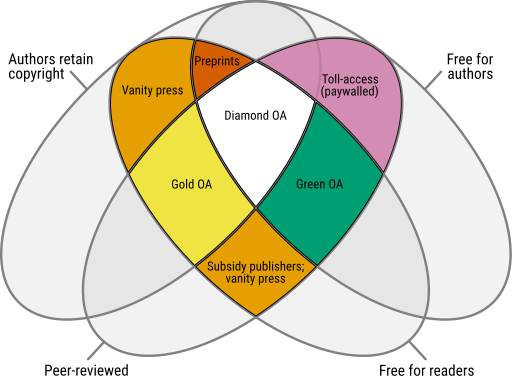
In the past, the value proposition of academic publishing has been seen through a simple two-sided paradigm that looked to either readers or authors (or their institutions on their behalf) as the sources of financial support for a journal. Readers would be willing to pay for access to knowledge in their field, or else authors would be willing to pay for access to venues where their work will be seen and valued in their field.
For Diamond OA, the value proposition is more collective. The entity paying the cost of publication (and often hosting the journal) isn’t paying to read or publish any particular article; they are paying to support a community service that benefits the institution, the scholarly society, or the public. Diamond OA sponsors have a wide variety of reasons to do this, not least among them a desire to counteract the known downsides of the alternatives for researchers and their institutions.
Our own Aperio Press is an example of a Diamond OA publisher. The UVA Library funds and operates Aperio, including the cost of publishing Aperio journals, as part of its commitment to sustainable scholarship. The Library is well-positioned to shop for publishing services, and the market for these services is much more transparent and competitive than the markets for journal subscriptions or article processing charges. For the cost of a couple of Nature article processing charges (literally two), we can publish dozens of articles per year in journals founded and operated by UVA scholars and make them available for free to the world. And because all Aperio journals must have a relationship to the University, supporting Aperio means supporting UVA scholars and scholarship. Establishing, managing, and editing a journal is important scholarly work, after all, and it is a wise investment to support that work directly. When you consider that the alternative is sending UVA editors out to find support from commercial actors who will turn around and erect price barriers against UVA readers, authors, or both, operating our own press becomes an even more obvious choice. Expanding this model throughout the scholarly ecosystem would free billions of dollars currently funneled to publisher oligopolies’ bottom lines to support actual research.
Aperio welcomes proposals from UVA faculty, staff, and students wishing to start new OA journals or transfer existing journals. The latter may include flipping a journal to open. More details about Aperio service offerings and applications are available at https://aperio.press/site/publish/. Proposals are accepted on a rolling basis and reviewed by Aperio’s Faculty Advisory Board on a quarterly basis. Consultations with Aperio’s Managing Editor (publish@virginia.edu) are highly recommended.
Postscript to the postscript
As I was finishing this blog post, the open access funders’ group cOAlition S released a proposal for broad reforms to scholarly publishing. Nature (of all places …) has a good write-up of the proposal, contextualizing it and gathering comments from several scholarly publishing experts. Platforms like Aperio (along with our open repository suite, Libra) would fit right in with this vision, as they are free to both readers and authors, they respect authors’ rights, and they encourage the early and open sharing of scholarly works.
5 Books for Native American Heritage Month
In honor of Native American Heritage Month, UVA Library recommends the following resources for insight into American Indian culture and history. The books and journals mentioned explore the wide variety of American Indigenous peoples and their contributions to what is now called the United States.
Thanks to Librarian for Collections Management and Video Resources Leigh Rockey, Librarian for History and Religious Studies Keith Weimer, and Reference Librarian Grace Hale for the recommendations below.
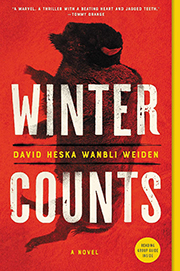 “Winter Counts” (Ecco, 2020)
“Winter Counts” (Ecco, 2020)
From page one, “Winter Counts” by David Heska Wanbli Weiden drives hard into the genre of crime fiction while also commenting on the metanarrative of American identity. The author, a member of Sicangu Lakota Oyate, has crafted a gritty, vigorous story that can be consumed in one sitting — it’s that compelling. The action centers on Virgil, the hard man who takes on the messy stuff that nobody else wants to do, as he follows a lead from Rosebud Reservation in South Dakota to Denver. Please note that this book contains descriptions of violence, references to sexual attacks, the death of a child, and drug use. –Leigh Rockey
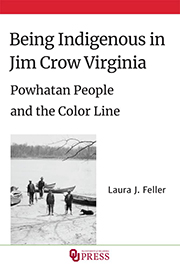 “Being Indigenous in Jim Crow Virginia: Powhatan People and the Color Line” (University of Oklahoma Press, 2022)
“Being Indigenous in Jim Crow Virginia: Powhatan People and the Color Line” (University of Oklahoma Press, 2022)
Post-Civil War/20th century white society’s fixation on a clear race-based divide created a complex reality for Native peoples, especially in Virginia, where the 1924 Racial Integrity Act included the infamous Pocahontas Exception. How did Indian communities fit together with whites’ construction of Black-white separateness? In “Being Indigenous in Jim Crow Virginia,” Laura J. Feller examines this question and more in her investigation of the extraordinary intersectional identities of tidewater Virginia’s American Indians. UVA Library’s own Regina Rush and her colleagues at the Albert and Shirley Small Special Collections Library helped the author with research. –Leigh Rockey
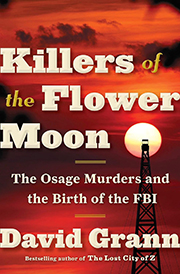 “Killers of the Flower Moon: The Osage Murders and the Birth of the FBI” (Doubleday, 2017)
“Killers of the Flower Moon: The Osage Murders and the Birth of the FBI” (Doubleday, 2017)
“Killers of the Flower Moon” by David Grann, recently adapted as a film directed by Martin Scorsese, chronicles the murders of more than 60 Osage tribespeople between 1918 and 1931. As we now know, white Oklahomans plotted the killings of tribespeople (including their own spouses and children) to acquire headrights to oil. Even great wealth and the fact “that numerous Osage had skillfully invested their money” were insufficient to protect them from systematic predation in a society dominated by unsympathetic whites. Media attention did spark enough national outrage that the FBI investigated and, with difficulty, brought some of the perpetrators to justice. Despite the injustices, Osage tribal integrity and culture have proven resilient. –Keith Weimer
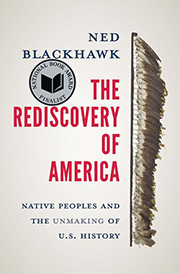 “The Rediscovery of America: Native Peoples and the Unmaking of U.S. History” (Yale University Press, 2023)
“The Rediscovery of America: Native Peoples and the Unmaking of U.S. History” (Yale University Press, 2023)
Yale historian and member of the Te-Moak Tribe of Western Shoshone, Ned Blackhawk reexamines the ways Indigenous groups have informed, responded to, and “reconstituted” modern America history in “The Rediscovery of America.” Beginning with pre-contact (pre-removal) maps and ending with analysis of the Termination Era (1953-1968) the book synthesizes both new and older scholarship into one volume, filling an ongoing critical need for historical and teaching works that contextualize the contributions of Native Americans beyond narrow Eurocentric conquest/settler narratives. –Grace Hale
“The Sentence” (Harper, 2021)
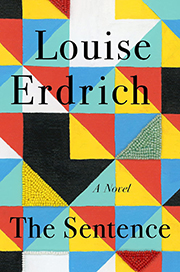 Louise Erdrich’s 2021 pandemic novel “The Sentence” is ostensibly about a haunting at a Minneapolis bookstore. The protagonist, Tookie, a Twin City area Ojibwe woman, invites the reader into a signature Erdrich worldview that knits together cooking, tongue-in-cheek comedy, history, philosophy, metaphysics, and Indigenous identity and politics.
Louise Erdrich’s 2021 pandemic novel “The Sentence” is ostensibly about a haunting at a Minneapolis bookstore. The protagonist, Tookie, a Twin City area Ojibwe woman, invites the reader into a signature Erdrich worldview that knits together cooking, tongue-in-cheek comedy, history, philosophy, metaphysics, and Indigenous identity and politics.
Part one of the book introduces the down-and-out Tookie in a tragi-comic body heist, but part two quickly moves in a metafictional direction when Tookie is released from jail and begins to build a life that nourishes her. Tookie now works in the Minneapolis bookstore, Birchbark Books, for a woman named “Louise”— a bookstore that Louise Erdrich owns in real life. Birchbark provides a backdrop to the literary haunting at the center of the story, although the haunting is quickly secondary to questions about community and belonging — ranging from the mundane (what to eat) to the tragic (George Floyd’s murder), to the metaphysical (can one create a heaven for one’s partner )— explored through the lens of Tookie’s experiences and the bookstore cast. –Grace Hale
In addition: a few recent journal issues
Studies in American Indian Literatures
The latest issue contains essays about Native women authors trying to bust open the many myths surrounding Sacajawea and a reconsideration of “Winter in the Blood” by James Welch.
Tribal College Journal of American Indian Higher Education
The news this fall concerning tribal colleges and universities includes the announcement of the first accredited Ph.D. program at a tribal college in the United States, the Doctor of Philosophy in Diné Culture and Language Sustainability at Navajo Tech in the Navajo Nation in New Mexico.
NAIS: Journal of the Native American and Indigenous Studies Association
The current issue offers a new translation of a letter sent from Timucua Native chiefs to the Spanish government in Florida in 1688. The letter is one of the oldest-known published texts in a Native language.
Browse by category
Browse by date
- November 2018 (1)
- August 2019 (1)
- November 2019 (1)
- January 2020 (1)
- November 2020 (1)
- January 2021 (1)
- September 2021 (2)
- October 2021 (1)
- November 2021 (1)
- January 2022 (4)
- February 2022 (2)
- March 2022 (2)
- April 2022 (1)
- May 2022 (3)
- August 2022 (1)
- September 2022 (2)
- November 2022 (4)
- December 2022 (3)
- January 2023 (6)
- February 2023 (9)
- March 2023 (11)
- April 2023 (6)
- May 2023 (4)
- June 2023 (3)
- July 2023 (1)
- August 2023 (3)
- September 2023 (5)
- October 2023 (7)
- November 2023 (3)
- December 2023 (5)
- January 2024 (4)
- February 2024 (8)
- March 2024 (2)
- April 2024 (6)
- May 2024 (4)
- June 2024 (1)
- July 2024 (2)
